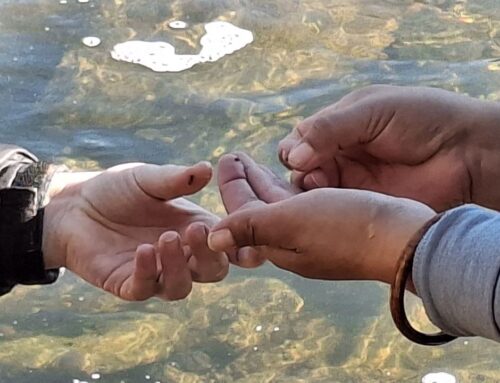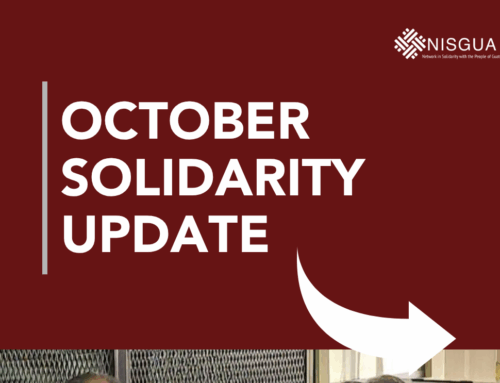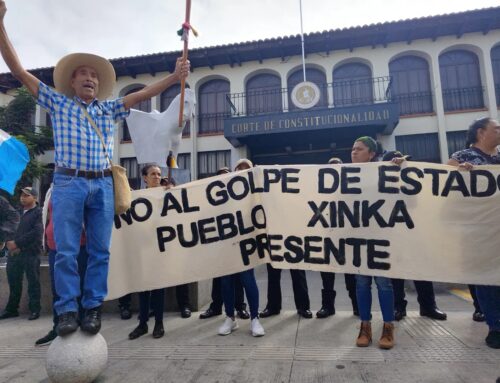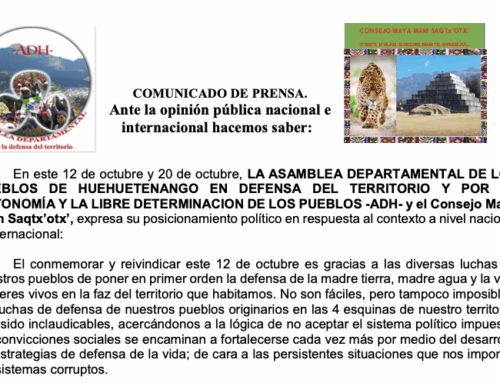By Alejandro Echeverría
October 13, 2014
 |
| Indigenous leaders Víctor Caal Tzuy and Ken Workman |
Ken Workman is a Seattle native who despite his tall stature, has characteristics that evoke his famous 19th century ancestor – the indigenous Chief of Seattle (Si’ahl) – who gave this city, which lies in the state of Washington on the Pacific coast of the northern United States, its name. Standing before a large audience at the Duwamish headquarters (the indigenous group to which he belongs), he speaks about his people and his struggle while alternating between the languages of Lushootseed and English. Beside him, Víctor Caal Tzuy, a Q’eqchi’ representative of Las Margaritas Copón, listens attentively while he readies himself to speak about his own struggle 4,500 kilometers to the south.
Ken speaks about the agreement his tribe made in the 19th century with the American colonists, in which they ceded their territory under imminent invasion and in exchange for money, the rights to inhabit the land, and to hunt and fish on it. They weren’t given an indigenous reservation like many other tribes who had the fortune of living in more remote areas unlike the geographically strategic city of Seattle. The Duwamish are not a recognized tribe. Many of them have been displaced, integrated into other tribes and lost their customs and cultural unity. Ken talked about current attempts to revive the Duwamish culture from the oral tradition that remains. “You have come at a good moment,” he says while looking at Víctor.
“Ma sa sa’ laach’ool?” greets Victor in Q’eqchi’ with a smile and a wave, after which he speaks in Spanish about the impacts that the construction of the Xalalá hydroelectric dam would have on surrounding communities in the Quiché and Alta Verapaz. In response to these impacts, they organized the Association of Communities for Development and the Defense of Land and Natural Resources (ACODET) in order to preserve their communities and consequently their culture.
The dam’s construction would directly affect 13,000 people living in the 50 communities that would be displaced, and indirectly affect another 18,000 people living in an additional 44 communities. If forced to reach an agreement with INDE, they would be displaced and have to integrate into other communities – a scenario that is all-too familiar. It is impossible to ignore the parallels with Ken’s history from almost 150 years ago, parallels that were brought to light on the “Rivers for Life” tour organized by the Network in Solidarity with the People of Guatemala (NISGUA).
In Washington, what was once the Duwamish River or Black River is now dry because it was transformed into a channel. In a surprising and sad coincidence, another river of the same name in Guatemala – the Rio Negro (“Black River”) – is in danger of suffering irreparable changes to the ecosystem and to the communities that depend on it. The communities in the area are organized, brave and made up of intelligent people who are concerned about local development – a concept that is not necessarily aligned with what we in the capital city perceive as “progress,”. And that’s good; why not? Self-determination is important. “In my river, the fishing is good and everyone is welcome except those who want to come to flood our communities,” said Victor, ending his presentation with a slide showing a picture of a child holding up a fish almost as tall as him.
While having coffee in the reception area of a local Seattle radio station where Víctor had given an interview, I learned about the local rules they have established for the proper management of hunting, fishing and the use of natural resources. These policies are much more reasonable than anything someone from Guatemala City with their smart phone in hand could find on Google. He talked a lot about the impact on the flora and fauna, and on the environment, the incomplete environmental studies, the fact that it is important to continue to generate electricity for the city – oh, the progress! – the many pros and cons, all of which come from a perspective that is so city-focused, but not at all cosmopolitan. In fact, there is little talk at all about the cultural impact.
Even though I already knew about the issues surrounding Xalalá and the history of the Duwamish separately, I never saw them side by side. It opened my eyes. There are communities in Guatemala, like those surrounding the Chixoy hydroelectric dam, that have gone through the same things as the Duwamish. We are in a unique context here, if we can only learn how to listen and decide to learn from history.
Translation by NISGUA






Leave A Comment